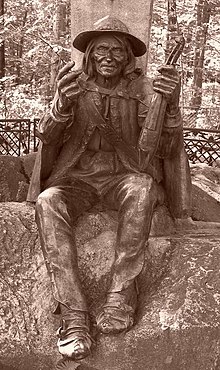Sabała
Sabała | |
|---|---|
 Sabała on a sketch by Stanisław Witkiewicz | |
| Born | Jan Gąsienica 26 January 1809 |
| Died | 8 December 1894 (aged 85) |
| Resting place | in Zakopane |
Sabała or Sablik, born Jan Krzeptowski (1809-1894) was a Polish highlander amateur musician, Tatra Mountains guide, storyteller and singer. A friend to many renowned Polish artists of the late 19th century, he is featured in numerous works of art of the epoch.
The nicknames such as Sabała or Sablik were traditionally used by highlander families to distinguish between various branches of extended families and are still in use today. Sabała, together with his brothers, adopted the surname of Krzeptowski to distinguish themselves from the rest of the large Gąsienica family.[1]
Life[]




In his youth he was a poacher and, reportedly, also a mountain highwayman. He took part in the failed of 1846, following which he spent some time in an Austrian prison. Set free, he abandoned his earlier life and, instead of settling down as a farmer, took up storytelling and playing music. For this reason local highlanders, and particularly so the wealthier gazdas, considered him a freak or a beggar. However, for scores of artists visiting the Tatra Mountains he became one of the symbols of the region and its culture. He accompanied Tytus Chałubiński and Stanisław Witkiewicz in their mountain expeditions. The latter dubbed him the "Homer of the Tatras".[2] In the end Sabała became a godfather to Witkiewicz's son, Stanisław Ignacy.
He was a frequent guest at Witkiewicz's house in Zakopane, where he entertained his host's guests with stories and songs, at one time he even staged a fake highwaymen attack on Helena Modjeska, in which he himself played the role of the .[3]
In his later years he settled in "Zacisze" villa in Zakopane, where took care of him.[2] He died 8 December 1894. He is buried at the in Zakopane.
His brother's great-granddaughter was , a conductor and one-time minister of culture of Poland.[4]
Music[]
The melodies composed by Sabała for an instrument called (a variety of gęśle) are collectively known under the name of Sabałowe nuty (Sabała's notes) and are still being played by highlander folk ensembles. Sabała himself rarely did play in a band or for dance, for him his music was a form of personal expression. His compositions were an inspiration to many later composers and musicologists, including Ignacy Jan Paderewski, Karol Szymanowski, , Adolf Chybiński and Jan Kleczyński.[5]
Sabała's złóbcoki, as well as numerous instruments modelled after his own, are preserved in the Museum of Musical Instruments, a division of the National Museum in Poznań.[6][7]
Literature[]

Sabała's folk tales (Polish: gawędy), both those invented by him and those he merely repeated after others, have been popularized by Stanisław Witkiewicz, Henryk Sienkiewicz, and others, who have published them in numerous collections, including:
- Bajki według opowiadań Jana Sabały Krzeptowskiego z Kościeliska, Bronisław Dembowski, 1892
- Sabała. Portret, życiorys, bajki, powiastki, piosnki, melodie, Andrzej Stopka Nazimek, 1897.
Thanks to Sabała's friendship with some of the more renown Polish authors of late 19th and early 20th centuries, he was featured as a semi-fictional protagonist in numerous works of literature, including by Henryk Sienkiewicz (Sabałowa bajka, 1884), Stanisław Witkiewicz (Na przełęczy, 1891), Kazimierz Przerwa-Tetmajer (Legenda Tatr, 1910), Władysław Orkan (novella Przez co Sabała omijał jarmark w Kieżmarku), Jalu Kurek (Księga Tatr, 1955) and (Ród Gąsieniców, 1954).
Legacy[]
In 1903 a monument to both Sabała and Tytus Chałubiński was unveiled in Zakopane by the Association of Friends of Zakopane. The monument was designed by Stanisław Witkiewicz and sculpted by . Although Sabała was thought of as a background for Chałubiński, the monument is commonly referred to as Sabała's monument, not Chałubiński's. Since the bow of Sabała's gęśle was frequently being stolen by vandals, the fifth (created by artist blacksmith Władysław Gąsienica-Makowski) was attached to the monument with heavy bolts and marked with an inscription asking Vandal, do not take me.[8][9]
In 1979 Sabała's house at was turned into one of the branches of the Tatra Museum, it returned to private hands in the following years, but is still available for tourists.[10]
There are streets named after Sabała in numerous Polish cities, including Zakopane, Warszawa, Bydgoszcz, Kraków, Łódź and Jelenia Góra. In Wolsztyn there is a ZHP troop named after him as well.[11]
References[]
- ^ Radwańska-Paryska, Zofia; Paryski, Witold H. (2004). Wielka encyklopedia tatrzańska (in Polish). Poronin: Wydawn. Górskie. ISBN 8371040091. OCLC 35208429.
- ^ Jump up to: a b Polak, Katarzyna (2011-04-06). "Homer Tatr. Jan Krzeptowski (Sabała)". Mapa Kultury (in Polish). Retrieved 2016-12-21.
- ^ Czuba, Przemysław (2009-02-17). "Tatrzańskie ciekawostki". fotkitatr.webpark.pl. Archived from the original on 2009-02-17. Retrieved 2016-12-21.
- ^ "Historia". za-wnukiem.pl. Retrieved 2016-12-21.
- ^ Pisera, Krzysztof (2013). Jak dawniej po Tatrach chadzano (in Polish). Zakopane: Wydawnictwa Tatrzańskiego Parku Narodowego. pp. 302–307. ISBN 9788361788638. OCLC 863119382.
- ^ Przerembski, Zbigniew J. "Polskie Instrumenty Ludowe: złóbcoki". ludowe.instrumenty.edu.pl. Retrieved 2016-12-21.
- ^ Jaskulski, Janusz; Przerembski, Zbigniew J. "Polskie Instrumenty Ludowe: złóbcoki". ludowe.instrumenty.edu.pl. Retrieved 2016-12-21.
- ^ Filip, Grzegorz (2003). "Pomnik Tytusa Chałubińskiego". Forum Akademickie. 9/2003. Archived from the original on 2011-04-06.
- ^ PAP (2006-05-18). "Pomnik Sabały doczekał się kolejnego smyczka". Wirtualna Polska (in Polish). Retrieved 2016-12-21.
- ^ Mierzejewska, Agata (2016-06-02). "Dom Sabały". Instrumenty muzyczne. Retrieved 2016-12-21.
- ^ "Aktualności". www.sloneczni.com.pl. Retrieved 2016-12-21.
Bibliography[]
- Polish male poets
- 1809 births
- 1894 deaths
- People from Zakopane
- People from Tatra County